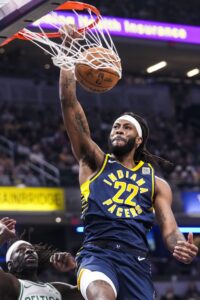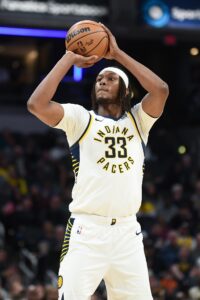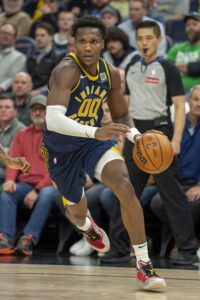Hoops Rumors is checking in on the 2025 offseason for all 30 NBA teams, recapping the summer’s free agent signings, trades, draft picks, departures, and more. We’ll take a look at each team’s offseason moves and consider what might still be coming before the regular season begins. Today, we’re focusing on the Indiana Pacers.
Free agent signings
 Isaiah Jackson: Three years, $21,000,000. Includes Achilles-related injury protection. Re-signed using Bird rights.
Isaiah Jackson: Three years, $21,000,000. Includes Achilles-related injury protection. Re-signed using Bird rights.- James Wiseman: Two years, minimum salary. First year partially guaranteed ($1MM). Second-year team option. Signed using minimum salary exception.
Trades
- Acquired their own 2026 first-round pick from the Pelicans in exchange for the No. 23 pick in the 2025 draft and the draft rights to Mojave King.
- Note: The Pelicans had acquired the Pacers’ 2026 first-round pick (with top-four protection) in a previous trade; the Pacers got it back in this deal.
- Acquired the draft rights to Kam Jones (No. 38 pick) from the Spurs in exchange for the Kings’ 2030 second-round pick and cash ($2.5MM).
- Acquired Jay Huff from the Grizzlies in exchange for the Trail Blazers’ 2029 second-round pick and the right to swap their 2031 second-round pick for either the Pacers’ or Heat’s 2031 second-round pick (whichever is least favorable).
Draft picks
- 2-38: Kam Jones
- Signed to four-year, $8,685,386 contract. First year guaranteed. Second year partially guaranteed ($1,075,459). Third year non-guaranteed. Fourth-year team option.
- 2-54: Taelon Peter
- Signed to two-way contract.
Two-way signings
- Quenton Jackson
- One year, $85,300 partial guarantee (will increase to $318,218 at start of regular season).
- Taelon Peter
- Two years, $85,300 partial guarantee (will increase to $318,218 at start of regular season); second year non-guaranteed.
Note: The Pacers carried over RayJ Dennis on a two-way contract from 2024/25.
Departed/unsigned free agents
- Thomas Bryant (unsigned)
- Enrique Freeman (Timberwolves)
- James Johnson (unsigned)
- Myles Turner (Bucks)
Other roster moves
- Exercised team option on Tony Bradley ($2,940,876).
Salary cap situation
- Operating over the cap ($154.6MM) and below the luxury tax line ($187.9MM).
- Carrying approximately $181.8MM in salary.
- Hard-capped at $195,945,000.
- Full non-taxpayer mid-level exception ($14,104,000) available.
- Full bi-annual exception ($5,134,000) available.
The offseason so far
Through 82 regular season contests and 22 of 23 total playoff games, 2024/25 was a dream season for the Pacers, who improbably overcame a 10-15 start to win three playoff series and then went toe-to-toe with the 68-win Thunder in the NBA Finals. But with Indiana looking to seize control of Game 7, star point guard Tyrese Haliburton – who was coming off a calf injury – tore his right Achilles tendon, ending his night, his season, and ultimately the team’s championship hopes.
Haliburton’s injury didn’t invalidate all the memorable performances, comebacks, and series victories that came before it, but it put a serious damper on one of the greatest years in team history — and it will have a lasting impact beyond the spring of 2025.
Even if the Pacers hadn’t won Game 7 in Oklahoma City, getting through that night without any serious injuries likely would’ve given the front office confidence to heavily invest in the roster going forward. Team owner Herb Simon hardly ever pays the luxury tax, but for a team that came within one win of a title and was in position to bring back its entire core, I think he would’ve been comfortable doing so.
 However, with Haliburton ruled out for the entire 2025/26 season, Indiana’s outlook for the coming year isn’t nearly as promising. Without their star player available, the Pacers almost certainly won’t be a serious championship contender next spring. That likely made Simon much more reluctant to become a taxpayer, which – in turn – resulted in the loss of longtime center Myles Turner in free agency to the division-rival Bucks.
However, with Haliburton ruled out for the entire 2025/26 season, Indiana’s outlook for the coming year isn’t nearly as promising. Without their star player available, the Pacers almost certainly won’t be a serious championship contender next spring. That likely made Simon much more reluctant to become a taxpayer, which – in turn – resulted in the loss of longtime center Myles Turner in free agency to the division-rival Bucks.
To be clear, the Pacers and Turner were very much engaged in contract talks when free agency started, and president of basketball operations Kevin Pritchard later insisted that ownership was willing to go “deep into the tax” to bring back the 29-year-old. Still, I have to think Indiana’s front office wasn’t quite as aggressive as it would have been if Haliburton were healthy.
While there were conflicting reports on exactly what the Pacers’ final offer to Turner was, most of those reports suggested the team hadn’t gone beyond a three-year bid worth about $22-23MM per year. That’s comfortably below what rival Eastern Conference centers like Jarrett Allen ($30MM per year), Jakob Poeltl ($28MM per year), and even Nic Claxton ($24.3MM per year) received on their most recent long-term contracts.
It seemed as if the Pacers were playing hardball with Turner to some extent, recognizing that no rival suitor had $20MM+ in cap room available and perhaps hoping that his price would come in low enough that they could duck under the tax line with a cost-cutting move elsewhere on the roster. Public remarks from Pritchard and general manager Chad Buchanan in the wake of Turner’s departure certainly suggested they weren’t expecting Milwaukee to find a way to open up the cap space necessary to give the big man a four-year contract worth in excess of $27MM annually. Turner reportedly accepted that offer without giving the Pacers a chance to match it.
With the rest of their starters and top reserves already under contract for the 2025/26 season, the Pacers dedicated much of their summer to finding a way to fill the new Turner-shaped hole in their frontcourt. They picked up Tony Bradley‘s non-guaranteed minimum-salary option and re-signed the centers who opened last season second and third on the depth chart behind Turner: Isaiah Jackson and James Wiseman.
Both Jackson and Wiseman suffered early-season Achilles tears of their own last fall, but Indiana clearly still believes both players are capable of providing positive minutes and is confident about how their recoveries are progressing.
I was pretty convinced that Jackson wouldn’t even get a qualifying offer, but the Pacers not only made him a restricted free agent, they re-signed him to a three-year, $21MM contract that will be fully guaranteed as long as he doesn’t have any recurring Achilles issues. As for Wiseman, he got a deal similar to the one he signed last year, a two-year, minimum-salary pact with a partially guaranteed first-year salary and a second-year team option.
Relying on a pair of big men coming off Achilles tears and a veteran journeyman would be risky, so the Pacers were also active on the trade market addressing the center position, acquiring Jay Huff from the Grizzlies in exchange for a future second-round pick and a second-round swap.
Huff is an intriguing pickup. He has put up monster numbers in the G League in recent years, and that production began to translate to the NBA level in 2024/25, as he averaged 6.9 points, 2.0 rebounds, and 0.9 blocks in 11.7 minutes per game across 64 outings for Memphis, with a .515/.405/.786 shooting line. I get the sense that the Pacers have high hopes for Huff, having brought in an assistant coach who worked closely with him at Virginia and reportedly helped convince the Grizzlies to take a shot on him a year ago.
Huff and Jackson will likely be fighting for the top spot on the Pacers’ depth chart at the five, with Wiseman and Bradley possibly vying for a spot on the 15-man regular season roster — neither player has a fully guaranteed deal, so if Jackson and Wiseman look healthy and effective, Bradley could be the odd man out.
Up next
With 15 players on standard contracts and three on two-way deals, the Pacers’ roster looks ready for the regular season, but there’s a little wiggle room there. As noted above, neither Wiseman nor Bradley has a guaranteed contract, so Indiana could waive one of them this fall in order to open up its 15th roster slot. In that scenario, Bradley would be the more likely release candidate, since he’s not owed any guaranteed money, whereas Wiseman has a $1MM partial guarantee.
If the Pacers do open up a roster spot, they wouldn’t be obligated to fill it right away and could create some additional roster and financial flexibility by leaving it open at the start of the season. But it’s also worth keeping an eye on veteran forward James Johnson, who remains unsigned. Buchanan said last month that Johnson hopes to continue his playing career, and Indiana has found room for him on its roster after the start of the season in the past.
 The more pressing items on the Pacers’ to-do list this fall will be a pair of potential contract extensions — Bennedict Mathurin is eligible for a rookie scale extension, while Aaron Nesmith is up for a veteran extension.
The more pressing items on the Pacers’ to-do list this fall will be a pair of potential contract extensions — Bennedict Mathurin is eligible for a rookie scale extension, while Aaron Nesmith is up for a veteran extension.
Both players will face an October 20 deadline, though Nesmith has two years left on his current deal and would become extension-eligible again starting in July 2026 if he doesn’t sign a new contract at this point. Mathurin, conversely, would be headed for restricted free agency next summer if he enters the season without an extension in place.
Nesmith has a more clearly defined role and more clearly defined extension parameters — the Pacers are limited to offering him up to three years and approximately $63MM on top of the $22MM he’s still owed over the next two seasons. That price seems reasonable for a player who has emerged as one of the club’s most reliable wings — Nesmith has averaged 12.1 points per game and made 42.3% of his three-point attempts over the past two seasons while admirably handling tough defensive assignments.
Mathurin has more upside than Nesmith as a scorer and an all-around offensive weapon, but his fit in Indiana’s Haliburton-led offense hasn’t exactly been seamless, so it’s unclear exactly how hard the team will push to get something done.
On one hand, it may make sense to extend Mathurin now before he takes on a larger role with Haliburton out and potentially has a career year in 2025/26. On the other hand, the Pacers simply may not be convinced he’s part of their long-term plans, especially if he’s seeking a deal north of $20MM per year — they avoided the tax this year, but a lucrative new contract for Mathurin would put them in danger of surpassing that threshold in 2026/27.
Wiseman it’s your time. You are up
“Only 22…. Only 23… Only 24” next years team will be like he’s “Only 25”
Thomas Bryant is a nice player, I dont understand why teams wont sign him
I think he is still a decent backup C. He doesn’t protect the rim at a high rate like some people expect. The NBA is cancelling out veterans